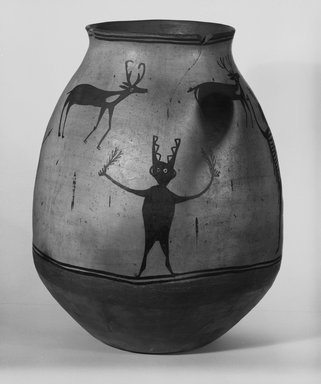Browse

| Accession # | 02.257.2471 |
|---|---|
| Culture | Ko-Tyit (Cochiti Pueblo) |
| Title | Water Jar or Olla |
| Date | late 19th century |
| Medium | Ceramic, pigment |
| Dimensions | 19 3/4 × 15 × 15 in. (50.2 × 38.1 × 38.1 cm) diameter at opening: 8 7/8 in. (22.5 cm) |
| Inscriptions | Catalogue number written in ink in middle of body surface. Small gummed label (20) is inside. |
| Credit Line | Riggs Pueblo Pottery Fund |
| Location | Visible Storage: Case 39, Shelf L (Native American Art) |
| Description | Jar with a grey body with the upper 3/4 covered with a brownish-white slip. The bottom has a red slip. A black design covers 3/4 of the body, seperated from the bottom by two black lines. The design is four human figures, two with bows and arrows, two with headdresses, and a row of four smaller deer along the top. Two black lines are at rim. Four chips in rim, one large chip leading to a crack halfway down one side. One large black spot from firing, one brown discoloration near bottom. |
Curatorial Remarks: NATIVE AMERICAN PUEBLO POTTERY
Pottery making was practiced in the southwestern United States for at least two thousand years. Zuni and Cochiti potters created the three vessels here: two water jars and one drum jar, which would have had a hide stretched over the top for beating with drumsticks. Historically, women were the potters, collecting their own clays, coiling and finishing each pot by hand, and firing the pieces in open fires.
Pots were often traded and exchanged between pueblos, so that new ideas were constantly being generated. During the 1880s the advent of the railroad brought an influx of trading posts and tourists into the Southwest and entrepreneurial potters began selling to the non-Native market. Today, both male and female potters continue to form traditional works as well as generate exciting new forms of Pueblo pottery.